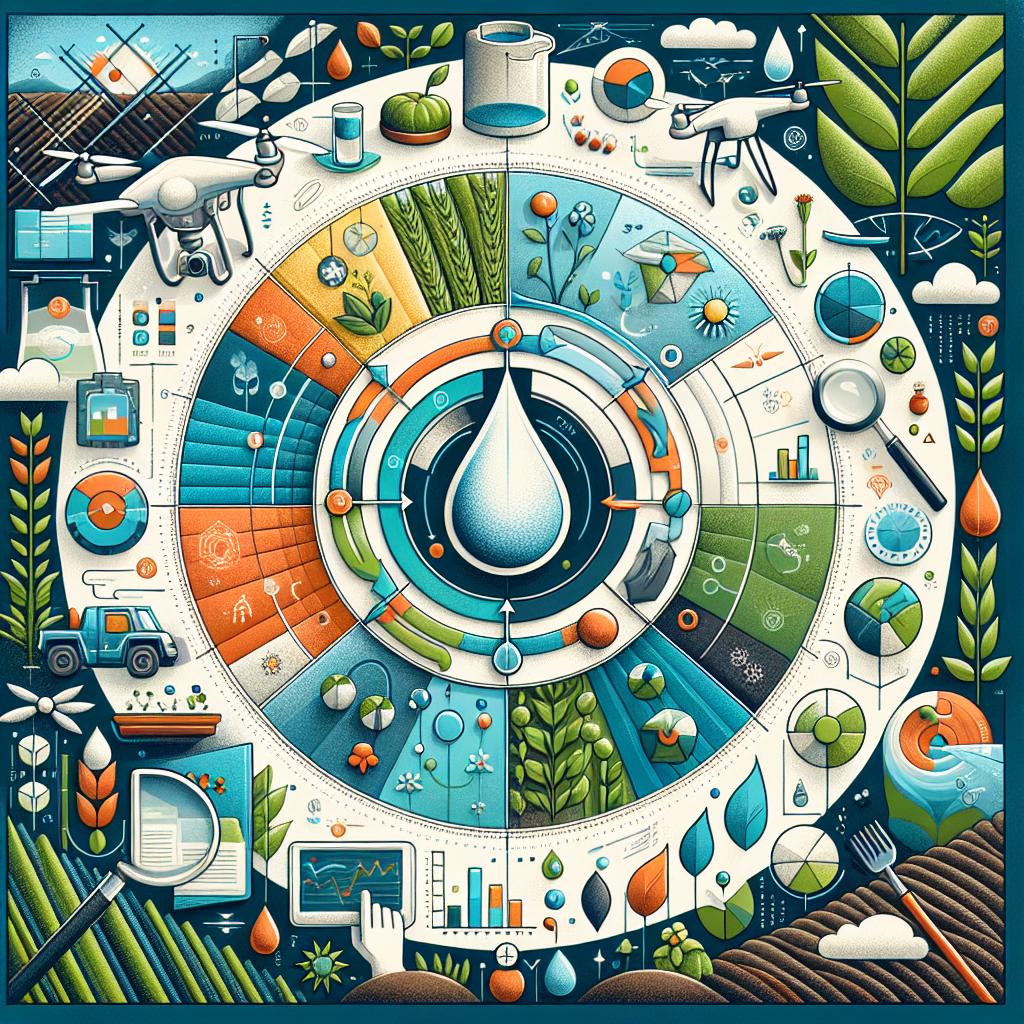This post may contain affiliate links which means I may receive a commission for purchases made through links. Learn more on my Private Policy page.
Introduction:
Imagine standing in a sun-kissed field, where vibrant rows of crops sway gently in the breeze, each one throbbing with life and potential. The secret to this verdant tapestry isn’t just the sun or the soil; it’s the water that permeates the ground, nourishing each plant in its own unique way. In the world of agriculture, one size rarely fits all, especially when it comes to water distribution. As we embark on an exploration of “Optimizing Water Distribution Patterns for Different Crop Types,” let’s celebrate the rich diversity of our plants and delve into the art and science of giving each crop what it truly craves. By understanding the specific water needs of various crops, we can cultivate healthier harvests, conserve precious resources, and ensure that our agricultural practices meet the challenges of tomorrow. So, grab your gardening gloves, and let’s journey through the innovative strategies and traditional wisdom that can help us create the most efficient water distribution systems tailored to every green thumb’s dream!
Understanding Crop Water Needs for Tailored Distribution
Every crop has its unique requirements when it comes to water intake, which significantly impacts their growth and yield. Understanding these requirements not only helps in achieving optimal health for each plant but also conserves water resources. For effective management, consider factors such as:
- Soil Type: Different soils retain moisture differently. Sandy soils drain quickly, while clay soils retain water.
- Crop Growth Stage: Seedlings require less water than mature crops, so tailoring the irrigation schedule to the growth stage is crucial.
- Weather Conditions: Rainfall, temperature, and humidity all affect evapotranspiration rates, influencing daily water needs.
To illustrate the variance in water needs, the following table summarizes the average daily water requirements for various crop types:
| Crop Type | Water Requirement (liters/day) |
|---|---|
| Tomatoes | 8-12 |
| Corn | 15-20 |
| Potatoes | 10-15 |
| Leafy Greens | 5-10 |
By tailoring water distribution to match these diverse needs, agronomists can enhance crop performance and contribute to sustainable farming practices. Whether through drip irrigation or rainwater harvesting, a nuanced understanding of each crop’s hydration will lead to thriving fields and reduced waste.

Harnessing Technology to Map and Monitor Irrigation Effectively
With the rapid advancement in modern technology, farmers now have access to tools that allow them to analyze and enhance their irrigation practices. By leveraging sensors, drones, and satellite imagery, it’s possible to generate precise maps that showcase soil moisture levels and crop hydration needs. These technologies facilitate a more targeted approach, ensuring that every drop of water is utilized efficiently. Here are some key benefits of using technology for irrigation mapping:
- Real-time Data Collection: Continuous monitoring ensures that farmers receive up-to-date information on soil conditions.
- Predictive Analytics: Data-driven insights allow for forecasting irrigation needs based on weather patterns and crop growth stages.
- Resource Optimization: Farmers can save water and reduce costs by applying the right amount of water at the right time.
Integrating technology into irrigation practices not only maximizes yield but also promotes sustainable farming. An effective monitoring system can drastically improve water distribution patterns tailored to specific crop needs. For instance, crops like corn may require deeper watering compared to less thirsty plants such as lettuce. Below is a simplified comparison of water requirements for various crops:
| Crop Type | Water Requirement (inches/week) |
|---|---|
| Corn | 1.5 – 2.0 |
| Wheat | 1.0 – 1.5 |
| Lettuce | 0.5 – 1.0 |
| Tomatoes | 1.0 – 1.5 |

Sustainable Practices to Enhance Water Efficiency and Crop Health
Implementing sustainable practices for water efficiency can significantly boost crop health while conserving valuable resources. By utilizing drip irrigation systems, farmers can deliver water directly to the roots, minimizing evaporation and runoff. This targeted approach not only enhances water distribution but also encourages deeper root growth, leading to stronger plants. Additionally, adopting rainwater harvesting techniques allows for the collection and storage of natural rainfall, which can be strategically used during drier periods, ensuring crops receive adequate moisture without over-relying on groundwater sources.
Soil health plays a crucial role in water retention and crop vitality. Integrating cover crops can improve soil structure and organic matter, enabling the ground to hold water more effectively. Partnering this practice with mulching helps reduce surface evaporation and suppress weeds, further optimizing moisture retention. The table below illustrates how various crops respond to different water distribution methods, highlighting the importance of tailoring strategies to specific agricultural needs.
| Crop Type | Watering Method | Optimal Frequency |
|---|---|---|
| Tomatoes | Drip Irrigation | Every 2-3 days |
| Rice | Flood Irrigation | Continuous during growth |
| Lettuce | Sprinkler System | Every day |
| Carrots | Soaker Hoses | Every 3-4 days |

Innovative Techniques for Adaptive Water Management in Agriculture
In the quest for sustainable agriculture, understanding how to tailor water distribution to the unique needs of various crops is paramount. By employing precision irrigation techniques, farmers can monitor soil moisture levels in real-time, allowing for the strategic allocation of water resources. This not only enhances crop health but also minimizes wastage. Key practices include:
- Drip Irrigation: Delivers water directly to the root zone, ensuring crops receive the exact amount needed.
- Smart Sensors: Adapt irrigation schedules based on weather predictions and soil conditions.
- Variable Rate Irrigation: Adjusts water application rates based on crop type and growth stages.
An innovative approach to optimizing water usage involves the analysis of crop water requirements, coupled with advanced modeling techniques. By creating a comprehensive water management plan, farmers can implement zoning strategies that focus on the specific geographical and climatic features of their fields. A simple categorization of crop types and their associated water needs can facilitate this process:
| Crop Type | Water Requirement (liters/week) |
|---|---|
| Vegetables | 60-80 |
| Cereals | 50-70 |
| Fruits | 80-100 |
The Way Forward
As we wrap up our journey through the intricate world of water distribution for diverse crop types, it’s clear that every drop counts. Just as each plant has its unique needs, so too must our approach to irrigation be tailored for maximum efficiency and yield. By understanding the specific water requirements and the nuances of different crops, we can cultivate not just healthier plants but also a more sustainable future.
Imagine a field where every seed thrives, each root reaches deep, and the land flourishes with vitality—this vision is within our grasp if we embrace the art and science of optimized water distribution. Whether you’re a seasoned farmer, a budding gardener, or an enthusiastic eco-warrior, remember that the roots of success lie in careful planning and mindful practices.
So, as you step out into your fields or gardens, carry with you the knowledge of how to nurture each crop’s individuality. May your efforts lead to bountiful harvests and a harmonious balance with nature. Here’s to a greener future, one drop at a time! Happy gardening! 🌱💧
This post may contain affiliate links which means I may receive a commission for purchases made through links. Learn more on my Private Policy page.
